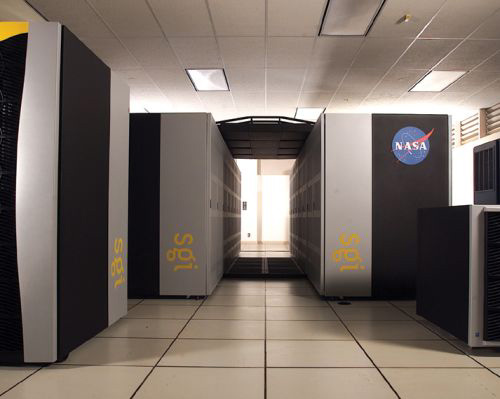NASA supercomputers join fight against coronavirus

As the U.S. scrambles to respond to the spreading COVID-19 pandemic, NASA supercomputers are joining the effort to look for potential treatment and vaccine candidates.
A new initiative brings together NASA and the National Science Foundation as well as a host of Department of Energy laboratories, companies and academic institutions. The White House announced the effort, meant to divert spare computing resources to research aimed at slowing the pandemic, today (March 23).
"I'm proud that @NASA is lending our supercomputing expertise to assist in the global fight against COVID-19," NASA Administrator Jim Bridenstine said in a statement on Twitter. "For more than six decades the agency has used its expertise to take on challenges that have benefited people worldwide in unexpected ways."
Related: Coronavirus prevention measures take their toll on astronomy
One of the areas of NASA redirecting its supercomputer time is the Earth science division, according to Science Mission Directorate head Thomas Zurbuchen. "Researchers input satellite data to run climate models to predict Earth's future climate," Zurbuchen said in a statement on Twitter. "NASA is pleased to lend our supercomputing expertise to assist in the global fight against #COVID19."
Researchers working on projects related to COVID-19 will be able to apply for time on the supercomputers, according to a White House statement, which should speed up calculations necessary for slowing the pandemic.
"America is coming together to fight COVID-19, and that means unleashing the full capacity of our world-class supercomputers to rapidly advance scientific research for treatments and a vaccine," Michael Kratsios, U.S. Chief Technology Officer, said in the statement.
Get the Space.com Newsletter
Breaking space news, the latest updates on rocket launches, skywatching events and more!
- Getting sick in space: How would NASA handle an astronaut disease outbreak?
- Dramatic effect of coronavirus lockdowns seen from space
- NASA center in California issues mandatory work-from-home order after employee tests positive for coronavirus
Email Meghan Bartels at mbartels@space.com or follow her @meghanbartels. Follow us on Twitter @Spacedotcom and on Facebook.
OFFER: Save at least 56% with our latest magazine deal!
All About Space magazine takes you on an awe-inspiring journey through our solar system and beyond, from the amazing technology and spacecraft that enables humanity to venture into orbit, to the complexities of space science.
Join our Space Forums to keep talking space on the latest missions, night sky and more! And if you have a news tip, correction or comment, let us know at: community@space.com.

Meghan is a senior writer at Space.com and has more than five years' experience as a science journalist based in New York City. She joined Space.com in July 2018, with previous writing published in outlets including Newsweek and Audubon. Meghan earned an MA in science journalism from New York University and a BA in classics from Georgetown University, and in her free time she enjoys reading and visiting museums. Follow her on Twitter at @meghanbartels.
-
dfjchem721 In the event current vaccines based on RNA fragments of the virus (SARS-CoV-2) fail to work, they need to move right away into viral protein antigen production. A protein-directed vaccine could also provide prolonged immunity should the virus mutate in certain areas of its genome and return. This would be similar to a fight against HIV infection, but perhaps not so hard with this virus's coat proteins. Time will tell. But if they are using the same technology (RNA based), past attempts do not bode well (see below). It seems prudent to initiate alternative approaches ASAP. Protein based vaccines are much more reliable. I suspect an attenuated virus vaccine is what we will end up with if the RNA vaccine fails, at any rate.Reply
It should be noted that "As of 2020, there is no cure or protective vaccine for SARS that has been shown to be both safe and effective in humans" (from Wiki):
https://en.wikipedia.org/wiki/COVID-19_vaccine
Since they have the RNA sequence of the virus , they should be able to run some programs using this sequence to estimate the most likely protein(s) and structure(s) that could be used in a vaccine (based on what is known about other viruses). They can also isolate antibodies from survivors of COVID-19 and use these polyclonal responses to probe the correct structures to target in protein vaccine development. The original SARS virus from 2002-2003 probably already provides the appropriate data for which protein(s) on this virus are best for a vaccine, despite the failure of prior vaccines against it.
The "right" protein(s), if they can be identified, could then be made by bacteria and cranked out in mass quantities by well established methods. An appropriate vaccine could then be constructed. The virus protein(s) might be used directly for injection (perhaps with adjuvant), or if required attached to some form of non-antigenic scaffolding. With this approach, you eliminate any kind of virus related infections as from "attenuated" virus, etc. You can also avoid growing up large amounts of the virus to make a direct virus-related vaccine. It should also speed regulatory approval since the active virus was never used to produce the vaccine.
Hint: The coat proteins will likely make the best antigens. Get with it!! -
He Never Helps Serious, apocalyptical stuff aside, I love this headline. I thought, "SEE? The robots don't wanna kill us all. Robots are nice!" 😊Reply










